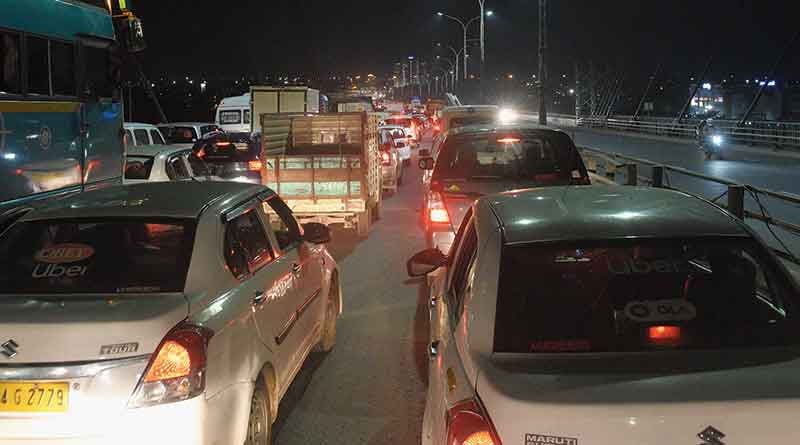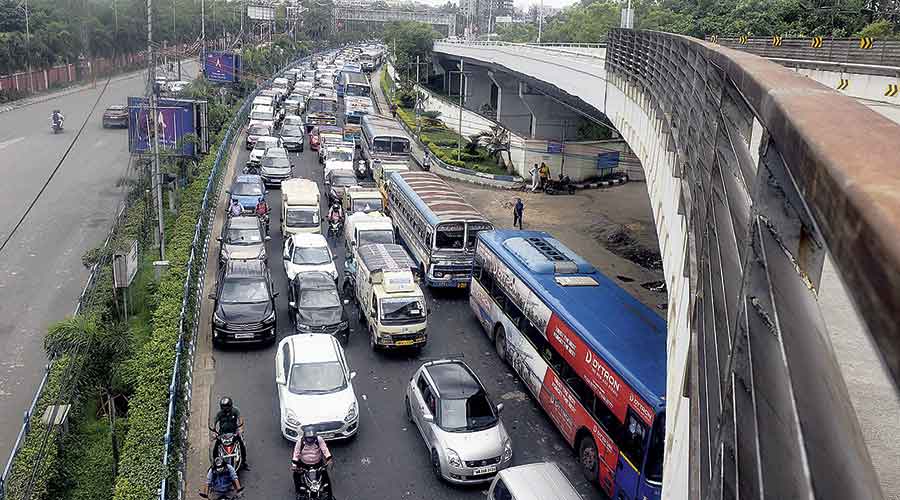Traffic snarls have returned to Calcutta though schools and colleges are shut and many Calcuttans are still working from home.
But those whose offices have reopened and who are commuting daily have told Metro how difficult their trips have become. Some of their complaints are:
- Traffic lights are not in sync with traffic flow
- Police intervention is late, especially when there is a jam
- Slight rain leads to waterlogging and slows down traffic; agencies are slow to react
- Cycles in the middle of the road, especially when there is hint of waterlogging along kerbs Niladri Nag, who drives his wife to her Salt Lake office daily through the Bypass, said the travel time between the Avishikta crossing and Science City had almost doubled between 10am and 10.30am. No traffic cops are visible on the stretch, he said.
Pramit Sarkar, who travels from Tollygunge to his Poddar Court office daily, said he was getting “unusually late” on SP Mukherjee Road. The maximum congestion is near Hazra crossing between 11am and noon, he said. “At times it feels the traffic signals are not working… the signal seems to be stuck at red.”
A professional said he was recently stuck in a traffic snarl on SP Mukherjee Road in the afternoon and by the time he reached the Exide crossing, vehicles were being diverted through the next crossing off Birla Planetarium. “Further ahead, my vehicle was diverted through the Air India crossing. All through I did not see any cop on the road,” he said.
Debraj Chatterjee, who has been working from his Behala home, had stepped out earlier this week for an official assignment and could cross Durgapur Bridge to reach Alipore in 40 minutes in the afternoon, a journey that usually takes 15 minutes.
Many people said they often got stuck on the Parama flyover no matter what time of the day.
Some motorists wondered if the number of cars had gone up because people were reluctant to use public transport. Every time there is a jam, the police blame something or the other: a car that has broken down, a waterlogged pocket, or slow traffic because of rain, they said.
Is there a larger problem because traffic jams are so widespread? There have been no reports of any signal malfunctioning, the police said.
“The traffic signal cycle had been reduced considerably in the initial days of the lockdown.
Now, it has been reversed to the normal timings,” a traffic police officer said. “Maybe commuters have got into the habit of waiting for short periods at traffic signals and now they are taking time to readjust.”
Senior officers refuted the allegation that traffic cops were few on the roads during the pandemic.
There are close to 3,000 traffic cops. They are assisted by 1,000 home guards and 2,000 civic volunteers, according to officers in Lalbazar.
At least 37 traffic cops are in hospital after testing positive for the coronavirus and 15 are in home quarantine as on Thursday. Earlier, 216 traffic cops had tested positive for the virus; but they have recovered and resumed duty, the police said.
Cops attributed the bumper-to-bumper jam on the Parama flyover to multiple vehicles breaking down on the flyover every day.

Vehicles on Vidyasagar Setu on Thursday evening and (below) on the airport-bound flank of VIP Road on Tuesday morning. Pictures by Pradip Sanyal and Bishwarup Dutta

Less than a week is left for Mahalaya. Every year during this time, traffic snarls are common as more and more people step out of their homes to shop. Vehicles are parked indiscriminately, pedestrians spill on to roads, there’s intermittent rain and waterlogging.
But this year is different because of the pandemic. Buses are few and shoppers or pedestrians are almost negligible. So, motorists and two-wheeler riders are surprised to find traffic snarls.
“Waterlogging on a small stretch on Central Avenue cannot be a reason for a 5km-long snarl… the tail of vehicles from MG Road reaching almost the Park Street flyover,” said a professional who was recently caught in a snarl on the Park Street flyover for 45 minutes on her way to office at Esplanade.
“Unlike other years, there are no pedestrians who usually slow down the traffic. The volume of vehicles may have increased but that is why we have traffic cops.”










